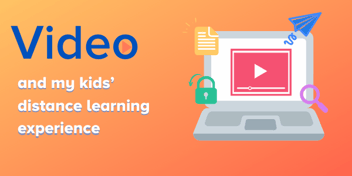As an unprecedented incident, few stakeholders were adequately prepared for the non-school-based education that’s been required in the wake of COVID-19. The crisis has left students, parents, teachers, school administrators, and companies that support them scrambling to adapt to the abrupt virtualization of education. It’s drastically changed the way we educate our children today, and it’s likely to reshape our approaches to education for the long-term.
Like many parents, I don’t have the time to spend working directly with my children in a 8 a.m. to 3 p.m,-focused schedule, nor do I have the skills, experience, or training to be nearly as effective as the great educators my children typically spend their weekdays with. But like many parents, I still want to deliver a meaningful education experience to our children.
Since I can’t transform into a qualified teacher overnight or find seven hours in my workday to devote to my children’s education, I know I need to provide them resources that will help them continue their academic success. The question on my mind, and I’m sure others’ minds as well has been: What can I do, as a parent, to both extend the instruction my children are getting and help them reflect on it?
<<Want to learn more about how you can amplify great teaching with video? Schedule a demo>>
Types of Virtual Learning
In online learning there are two primary modes of education:
- Synchronous – meaning the education happens in real time (for example, a live virtual classes)
- Asynchronous – meaning students complete work on their own time (for example, watching recorded lectures)
There are benefits and challenges of each mode, but in today's world neither is a complete solution. With the current crisis we’re all adjusting to, it’s not a reality for all classes to be through Google Hangouts or for our teachers to record 4+ hours of instruction a day for asynchronous consumption of their lectures—nor do I think that would be effective as our students’ attention spans rarely support long lectures (BBC, 2019) .
The goal instead should be to complement synchronous learning with asynchronous tools and virtual instruction. By providing resources that allow students to engage deeper with content and giving them additional context for the lesson at hand, students can bring those insights back to a synchronous group. This sets up the best of both worlds in today's new digital learning environment.
.jpg?width=578&name=hal-gatewood-alntq-WvZZM-unsplash%20(1).jpg)
The Place for Video in Online and Distance Learning
Video offers an interesting solution to the synchronous vs. asynchronous learning debate.
It shouldn’t be a surprise that video is the preferred learning modality for today's students (Kaltura, 2018). The benefits of video can be considerable and can allow for learning in different ways:
- Increased instructional time: By having diverse and engaging sets of instructional video, with set learning objectives in mind, videos can be a mini lesson on-demand
- Allow students to process concepts at their own pace: Students progress at their own pace, and with video students have the ability to pause, rewind and review content to meet their needs.
- Increased engagement: Video has also been proven, if implemented and supported by the right instructional supports, to increase student engagement—something especially critical right now
- Diversity of perspectives: Providing a diverse set of videos helps to provide different points of view and styles to “provide differentiated approaches on the same subject”
In addition to these benefits, by incorporating video, teachers and parents can give children material that can be consumed on their own time (asynchronous) but discussed in real time (synchronous). For videos to be truly effective as a teaching tool, they should be coupled with short quizzes, assignments or projects to add that much more value to the content.
Where to Find Education Videos for Students
I want my kids to spend more time with trusted and proven educational content that can increase their instructional time. For me video is a powerful and proven option, but it can’t be just any video, and it can’t be accompanied by ads, distractions, or inappropriate content. (In other words, it can’t be YouTube).
Because of my job, I have access to an educational video platform that was designed by teachers, for teachers, that has the best educational videos without all the “junk” that comes with open video platforms. Since the school shutdowns, I’ve been using Boclips for Teachers to give my kids videos related to what they’re learning, which has made this sudden shift to distance learning easier on us, our kids, and I would imagine their teachers as well when my kids have new insights to share based on what they’ve watched.
I’m happy to share that Boclips is opening up access to the platform to give more parents another way to extend instructional time and keep their sanity during these crazy times. This means that parents can now access the same quality, vetted educational videos that teachers share with their students. Learn more and sign up here.
Sources
https://www.bbc.com/worklife/article/20190220-how-can-a-distracted-generation-learn-anything
https://www.pearson.com/content/dam/one-dot-com/one-dot-com/global/Files/news/news-annoucements/2018/The-Next-Generation-of-Learners_final.pdf
Liou, W., Bhagat, K.K. & Chang, C. Beyond the Flipped Classroom: A Highly Interactive Cloud-Classroom (HIC) Embedded into Basic Materials Science Courses. J Sci Educ Technol 25, 460–473 (2016). https://doi.org/10.1007/s10956-016-9606-8
Zach Tussing
Zach leads Boclips' business partnerships in the US and has spent the last 15 years in the EdTech space. He has two sons, 12 and 8.
- #Classroom
- #Video in Digital Learning
- #Educational Videos
- #Tips for Using Video
- #Video Content Partners
- #Boclips for Publishers
- #Issues in Education
- #Educational Videos by Subject Area
- #News and Announcements
- #Events & Holidays
- #Video and Teaching Tools
- #Teaching Methodologies
- #Education Videos
- #Video and Digital Literacy
- #Short Educational Videos
- #Instructional Design
- #Multimodal Learning
- #Video and Student Safety
- #Accessibility in Education
-3.png?width=390&height=223&name=Untitled%20design%20(2)-3.png)


.png?width=1152&height=660&name=Copy%20of%20Untitled%20Design%20(1).png)



